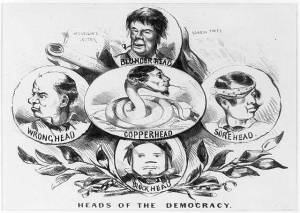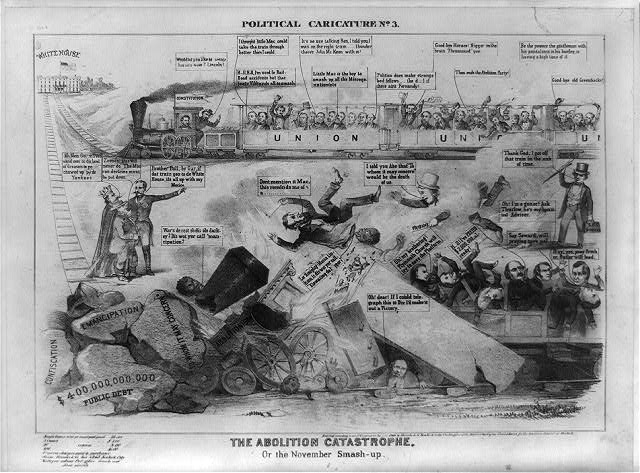red all over … but a lot less than Democrats claim.
Democrat newspapers claimed the public debt would be $4 billion by the end of the war. A Republican publication calculated the debt as of September 30, 1864 as about $2 billion.
From The New-York Times October 24, 1864:
NEWS FROM WASHINGTON.; THE AMOUNT OF THE PUBLIC DEBT.
Special Dispatches to the New-York Times.
The Copperhead press, acting upon the principle, doubtless, that a lie well stuck to is as good as the truth, continue to reiterate their statements respecting the increase of the public debt, but with this difference — they have increased the amount from $3,000,000 to $4,000,000. In view of this malicious ignorance, the following data are given for their information:
The public debt on the 7th March, 1861, (the day on which Mr. CHASE entered upon the administration,) was:
Funded………………….$59,992,887 64
Treasury Notes outstanding. 16,462,411 64
Total debt 7th March, 1861.$76,455,299 28
On the 1st July, 1861………$90,867,828 68
Four months — 115 days……. 14,412,529 40
Increase per diem……… $125,330 00
Increase from 1st July, 1861, to 1st May, 1863, 22 months — 669 days……………… $876,331,899
Increase per diem………. $1,309,913
Increase from 1st May, 1863, to 26th April, 1864, 12 months — 360 days……………… $689,615,378
Increase per diem………. $1,915,598
Increase from 26th April, 1864, to 30th September, 1864, 157 days — 5 months.. $299,158,711
Increase per diem…….. $1,905,469
Increase from 1st July, 1861, to 30th September, 1864, 1,187 days — 39 months……$1,865,105,888
Average increase per diem since 1st July, 1861……. $1,571,108
It will be observed that in the general average of the increase of the debt, the first four months of the rebellion are not embraced; if they were thrown into the term, the effect would be to reduce the per diem increase of debt to $1,443,562, but these first 115 days are rejected because their expenditure bears no tolerable proportion to the rate of increase after the 1st July, 1861.
The long periods of 22, 12 and 5 months, are taken because they respectively represent the fairest examination of the subject. The first of these periods covers the time during which it was customary among the opponents of the Administration to put the daily expenditure at three millions a day. The two later periods of 12 and 5 months embrace the time in which they have stated the increase of debt at four millions a day. For these estimates they have no data whatever, and only a single item of conjecture — the floating debt, as it is miscalled, meaning the accruing debt, not ascertained or not brought into the department for settlement.
It is true, for instance, that on the day previous to the periodical payment to the army, so much as is then due on this account is not embraced in the official statement of the debt for that day; in like manner and for the same reason, the claims maturing for army and navy supplies of all kinds are not embraced before they are officially known. Yet so much of such claims as are ascertained, either upon settlement in the war and navy departments, or drawn for by them in advance, whether paid or not, invariably goes into the Treasury statements made public by the Secretary, and appears there either as bonds, certificates of indebtedness, or unpaid requisitions. At all events it is clear that as such claims do not stand long unsettled, those of, say our first period, must appear in the second, and those of the second in the third period, which we have taken in our statement of the average per diem increase of the debt, leaving of this unknown, unsettled or unmatured debt no more than shall have been accruing within the last period of five months, for which fifty millions would be an excessive allowance.
The total debt, thus understood, was, on the 30th of September, 1864, $1,955,973,716, or may be stated at $2,000,000,000, and no more, if made to embrace the conjectured amount not made known on that day. Of this known total the amount bearing interest was $1,487,671,814, at an average rate of 5 1/2 per cent. The amount of the debt, without interest, was as follows:
United States notes………………….$433,160,569
Fractional currency…………………. 24,502,412
Amount on which interest had ceased…. 356,970
Suspended requisitions………………. 34,641,364
Total…………………………..$492,661,315
which, reduced by the amount in the Treasury, $24,359,411, leaves the debt as above stated at $1,955,973,716, and the rate of interest averaged to the whole debt 4 1-5 per cent. The average rate of 5 1/2 per cent. upon the interest bearing part of the debt is thus explained.
The whole loan of $140,000,000, issued in 1861, at 7 3-10 per cent., had fallen due, and was payable or convertible into 6 per cent. bonds on the 1st of October. The new issue of 7-30s. under the act of June 30, 1864, amounted to $55,897,600. The compound interest notes, at the equivalent of 6-46 per cent. per annum, amounted to $102,329,680, and $238,697,456 was at 5 per cent., and $548,224 at only 4 per cent., the balance being at 6 per cent. — the average, as before stated, standing at 5 1/2 per cent.
The total amount of interest per annum was: Gold, $54,608,445 70; Currency, $27,170,197 42.
We have thus given the data for our calculations, and the reasons for our estimates, and submit them for the study of those who would willingly know the truth.
According to the Treasury Department’s Bureau of the Public Debt, “The American Civil War resulted in dramatic debt growth. The debt was just $65 million in 1860, but passed $1 billion in 1863 and had reached $2.7 billion following the war.” The same page quotes Alexander Hamilton from 1790 as saying, “The United States debt, foreign and domestic, was the price of liberty … [one of the many purposes of the public debt was] to cement more closely the Union of the States …”
It seems like the following pro-McClellan cartoon is really exaggerating the public debt – to $400 billion:



